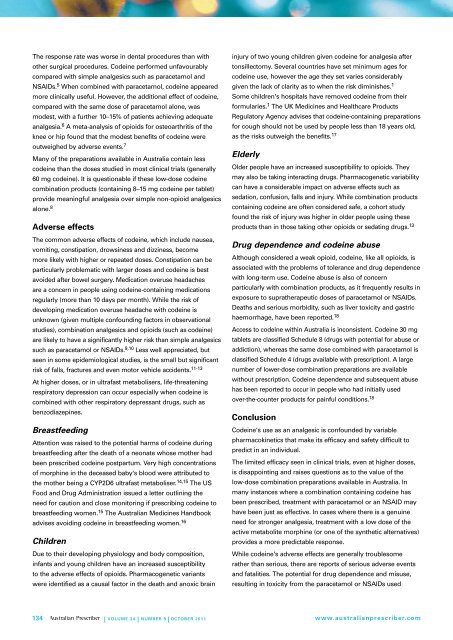Cautions with codeine - Australian Prescriber
Cautions with codeine - Australian Prescriber
Cautions with codeine - Australian Prescriber
Create successful ePaper yourself
Turn your PDF publications into a flip-book with our unique Google optimized e-Paper software.
The response rate was worse in dental procedures than <strong>with</strong>other surgical procedures. Codeine performed unfavourablycompared <strong>with</strong> simple analgesics such as paracetamol andNSAIDs. 5 When combined <strong>with</strong> paracetamol, <strong>codeine</strong> appearedmore clinically useful. However, the additional effect of <strong>codeine</strong>,compared <strong>with</strong> the same dose of paracetamol alone, wasmodest, <strong>with</strong> a further 10–15% of patients achieving adequateanalgesia. 6 A meta-analysis of opioids for osteoarthritis of theknee or hip found that the modest benefits of <strong>codeine</strong> wereoutweighed by adverse events. 7Many of the preparations available in Australia contain less<strong>codeine</strong> than the doses studied in most clinical trials (generally60 mg <strong>codeine</strong>). It is questionable if these low-dose <strong>codeine</strong>combination products (containing 8–15 mg <strong>codeine</strong> per tablet)provide meaningful analgesia over simple non-opioid analgesicsalone. 8Adverse effectsThe common adverse effects of <strong>codeine</strong>, which include nausea,vomiting, constipation, drowsiness and dizziness, becomemore likely <strong>with</strong> higher or repeated doses. Constipation can beparticularly problematic <strong>with</strong> larger doses and <strong>codeine</strong> is bestavoided after bowel surgery. Medication overuse headachesare a concern in people using <strong>codeine</strong>-containing medicationsregularly (more than 10 days per month). While the risk ofdeveloping medication overuse headache <strong>with</strong> <strong>codeine</strong> isunknown (given multiple confounding factors in observationalstudies), combination analgesics and opioids (such as <strong>codeine</strong>)are likely to have a significantly higher risk than simple analgesicssuch as paracetamol or NSAIDs. 9,10 Less well appreciated, butseen in some epidemiological studies, is the small but significantrisk of falls, fractures and even motor vehicle accidents. 11-13At higher doses, or in ultrafast metabolisers, life-threateningrespiratory depression can occur especially when <strong>codeine</strong> iscombined <strong>with</strong> other respiratory depressant drugs, such asbenzodiazepines.BreastfeedingAttention was raised to the potential harms of <strong>codeine</strong> duringbreastfeeding after the death of a neonate whose mother hadbeen prescribed <strong>codeine</strong> postpartum. Very high concentrationsof morphine in the deceased baby's blood were attributed tothe mother being a CYP2D6 ultrafast metaboliser. 14,15 The USFood and Drug Administration issued a letter outlining theneed for caution and close monitoring if prescribing <strong>codeine</strong> tobreastfeeding women. 15 The <strong>Australian</strong> Medicines Handbookadvises avoiding <strong>codeine</strong> in breastfeeding women. 16ChildrenDue to their developing physiology and body composition,infants and young children have an increased susceptibilityto the adverse effects of opioids. Pharmacogenetic variantswere identified as a causal factor in the death and anoxic braininjury of two young children given <strong>codeine</strong> for analgesia aftertonsillectomy. Several countries have set minimum ages for<strong>codeine</strong> use, however the age they set varies considerablygiven the lack of clarity as to when the risk diminishes. 1Some children's hospitals have removed <strong>codeine</strong> from theirformularies. 1 The UK Medicines and Healthcare ProductsRegulatory Agency advises that <strong>codeine</strong>-containing preparationsfor cough should not be used by people less than 18 years old,as the risks outweigh the benefits. 17ElderlyOlder people have an increased susceptibility to opioids. Theymay also be taking interacting drugs. Pharmacogenetic variabilitycan have a considerable impact on adverse effects such assedation, confusion, falls and injury. While combination productscontaining <strong>codeine</strong> are often considered safe, a cohort studyfound the risk of injury was higher in older people using theseproducts than in those taking other opioids or sedating drugs. 13Drug dependence and <strong>codeine</strong> abuseAlthough considered a weak opioid, <strong>codeine</strong>, like all opioids, isassociated <strong>with</strong> the problems of tolerance and drug dependence<strong>with</strong> long-term use. Codeine abuse is also of concernparticularly <strong>with</strong> combination products, as it frequently results inexposure to supratherapeutic doses of paracetamol or NSAIDs.Deaths and serious morbidity, such as liver toxicity and gastrichaemorrhage, have been reported. 18Access to <strong>codeine</strong> <strong>with</strong>in Australia is inconsistent. Codeine 30 mgtablets are classified Schedule 8 (drugs <strong>with</strong> potential for abuse oraddiction), whereas the same dose combined <strong>with</strong> paracetamol isclassified Schedule 4 (drugs available <strong>with</strong> prescription). A largenumber of lower-dose combination preparations are available<strong>with</strong>out prescription. Codeine dependence and subsequent abusehas been reported to occur in people who had initially usedover-the-counter products for painful conditions. 18ConclusionCodeine's use as an analgesic is confounded by variablepharmacokinetics that make its efficacy and safety difficult topredict in an individual.The limited efficacy seen in clinical trials, even at higher doses,is disappointing and raises questions as to the value of thelow-dose combination preparations available in Australia. Inmany instances where a combination containing <strong>codeine</strong> hasbeen prescribed, treatment <strong>with</strong> paracetamol or an NSAID mayhave been just as effective. In cases where there is a genuineneed for stronger analgesia, treatment <strong>with</strong> a low dose of theactive metabolite morphine (or one of the synthetic alternatives)provides a more predictable response.While <strong>codeine</strong>'s adverse effects are generally troublesomerather than serious, there are reports of serious adverse eventsand fatalities. The potential for drug dependence and misuse,resulting in toxicity from the paracetamol or NSAIDs used134 | Volume 34 | NUMBER 5 | OCTOBER 2011 www.australianprescriber.com
















